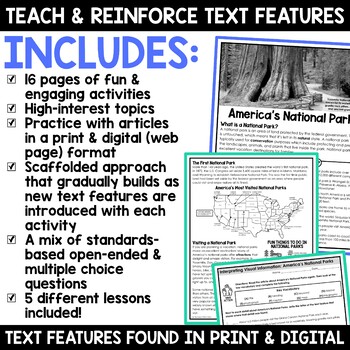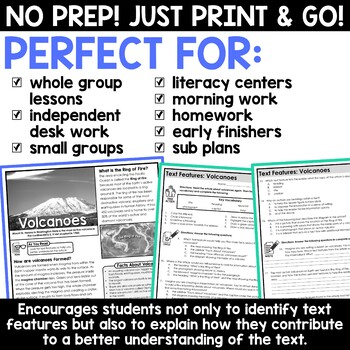Nonfiction Text Features for Informational Text Worksheets and Assessments
- PDF
- Easel Activity
What educators are saying
Description
Do your students struggle to explain the purpose of nonfiction text features? This resource encourages students to not only identify text features but also explain how they contribute to a better understanding of informational text. These no-prep worksheets, reading passages, and activities will help you teach and reinforce text features found in print and digital (web page) formats.
This nonfiction text features practice pack includes 16 pages of fun and engaging activities perfect for students in 3rd and 4th grades. From towering giraffes to volcanoes and national parks, each passage and article includes a high-interest topic that students will love to read about!
A scaffolded approach
This resource gradually builds as it introduces new text features with each activity. A mix of standards-based open-ended and multiple-choice questions are woven throughout each page. In a scaffolded approach, students will steadily practice identifying, explaining, and understanding text features found in informational text such as:
•title
•heading
•keyword
•sidebar
•photograph
•caption
•hyperlink
•search tool
•map
•diagram
•timeline
•infographic
…and more!
⭐ Check out the preview to see more!
These activities are perfect for…
•whole group lessons
•independent desk work
•small groups
•literacy centers
•morning work
•homework
•early finishers
•sub plans
The best part?
This resource is easy to use! Add these activities to any unit or study on nonfiction text features and/or informational text. Students can easily practice locating text features while also explaining how they contribute to an understanding of the text in which they appear.
In this one convenient resource, you can…
•have ready-to-go activities that will help your students master non-fiction text features and explain how they contribute to a better understanding of informational text.
•use these pre-made text features activities as sub plans when you need to take a day (or week) off!
•print and go - includes everything you need to teach or reteach NON-FICTION TEXT FEATURES anytime during the year!
Supports Common Core Standards (CCSS):
RI.3.5, RI.3.7
RI.4.7
You may also like…
Main Idea & Supporting Details Print and Digital
Teaching Theme with Aesop's Fables Print and Digital
Compare Contrast Themes & Topics Across Cultures Print or Digital
Click ★HERE★ to follow my store and be notified when new products are uploaded.
All new resources are 50% off for the first 24 hours!
⭐ Please note: If you are having difficulty with this file, please visit the FAQs section, submit a help ticket, or ask me a question on the Q&A tab before leaving feedback.
Copyright © Kim Miller (A Love of Teaching)
Permission to copy for single classroom use only.
Please purchase additional licenses if you intend to share this product.






